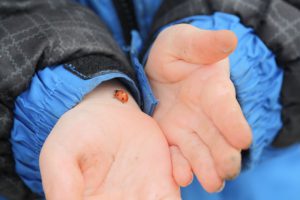Hungry, Hungry Ladybugs
Views: 4281

We’re in the middle of April, and it’s still cold. As a matter of fact, our forecast calls for 1 to 3 inches of snow today. So I must admit I’m a little surprised with how many ladybugs we’re finding when the boys and I are working in the garden. John seems to be the one who spots them. I think he’s picked up 10 to my 1 all spring. But it just seems very early to be seeing so many ladybugs, which made me wonder about their lifecycle.
Lifecycle of a Ladybug
Ladybugs can have 4 to 6 generations each season depending on your location since warmer regions will have more time to hatch out new batches of ladybugs. The ones we see now are the adults that were hatched in the fall. In some parts of the country, they’re a huge nuisance because they’re smart enough to know the best place to be is in the warm house so some of you might see them in your home by now. But around here, they seem to stay burrowed in garden debris (and boy did I have a lot of it last year!). So, as the weather starts to warm, they emerge.
The next step will be when the females lay eggs, although they really need a viable food source in order to produce a successful hatch. She’ll have 10 to 15 eggs that look like light colored footballs set on end on a leaf near something they can eat, which is namely aphids or mites so they are helpful at even a very young age. When the larvae hatch they might be up to a ½ inch long, and resemble a fly we might use in fly fishing out here. (Dark and fuzzy with orange spots.) The larvae will be around for 2 to 3 weeks before they pupate. They usually hang tight on a leaf, and encrust themselves in a casing for a couple of days. The next step is the adult ladybug. This process continues multiple times throughout the warmer months.
What Do They Eat?
A little tidbit of information I found during my research in their lifecycle is how much they eat. We all know that they do a number on aphid populations, but I discovered that one ladybug can eat 5000 aphids in its lifetime. That’s beating even my record with Oreos. They’re a tremendous asset in the garden. And because of this some people might be surprised to hear that this is one reason we don’t want to go full on assault to so many “pests” we see on our plants. If you have some aphids, remember it is a ladybug buffet. Keep your finger off the trigger of the spray bottle for a while to see if the ladybugs will keep the population in check.
I’m happy to see the ladybugs, even though I worry the poor little things are coming out too early. Maybe they normally come out this time of the year, but I am noticing them more because of the cold. But I wonder what they will eat. I suppose they can find mites to eat, but I don’t think they’re going to find aphids anywhere for at least a month, maybe longer if this bizarre cold weather trend continues. I will keep you posted on how our ladybugs fair this year. Last year we had a large number of them in the garden, and if the trend continues it looks like another healthy ladybug season.
Meet Amy Grisak
Amy is a freelance author and photographer in Great Falls, MT who specializes in gardening, foods, and sustainable agriculture. She provides information on every kind…
Amy's Recent Posts

Watch for Fungal Diseases on Penstemon








